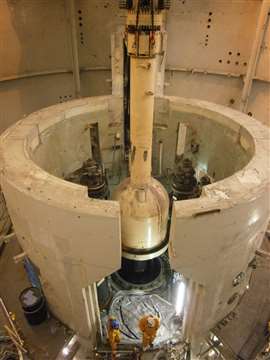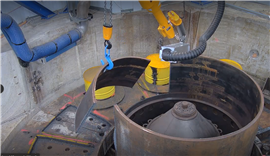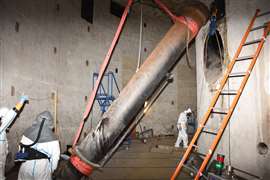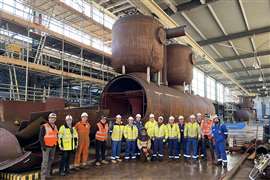Dragon nuclear reactor dismantling progresses at Winfrith
20 February 2025
Nuclear Restoration Services (NRS) has made significant progress in the dismantling of the Dragon reactor at the Winfrith site in Dorset, with almost half of the upper shielding structures removed using robotic laser cutting technology.
 The Dragon reactor. (PHOTO: Nuclear Restoration Services)
The Dragon reactor. (PHOTO: Nuclear Restoration Services)
Winfrith was established in the 1950s as a centre for nuclear reactor research. Seven of its nine experimental reactors have already been decommissioned, with work now focusing on its remaining Dragon and Steam Generated Heavy Water reactors.
Dragon, which operated from 1964, was a prototype 20-megawatt graphite-moderated, helium-cooled reactor used for high-temperature nuclear fuel testing.
 Laser cutting the Dragon reactor neck ring. (PHOTO: Nuclear Restoration Services)
Laser cutting the Dragon reactor neck ring. (PHOTO: Nuclear Restoration Services)
According to NRS (formerly known as Magnox), the current phase of decommissioning involves the removal of one-inch-thick carbon steel plates that make up the Top Ring Thermal Shield.
A telescopic mast-manipulator robotic arm, equipped with a laser cutter, is being used to cut and extract these components from a remote control room.
Andy Philps, NRS Senior Project Manager, said: “It is fantastic to start the core dismantling after years of meticulous in-house engineering design, planning and decommissioning of the sub-systems in preparation for this phase.
“Once the upper shielding structures are removed, we will have access to the top of the reactor pressure vessel and then the core within.”
The dismantling process involves laser cutting, which was initially tested on mock-up components at the Welding Institute in Cambridge before being trialled on a full-scale model at Winfrith.
In 2018, a robotic system, known as Lasersnake, was used to remotely cut a heat exchanger vessel from Dragon’s reactor core.
 The Purge Gas Pre-cooler being removed in 2018. (PHOTO: Nuclear Restoration Services)
The Purge Gas Pre-cooler being removed in 2018. (PHOTO: Nuclear Restoration Services)
Phoebe Lynch, Strategic Innovation Programme Manager at Nuclear Restoration Services (NRS), said: “All the learning from the initial operational phase of using laser cutting for the Dragon reactor core provided valuable insights into the feasibility, reliability and safety of this technique.
“These have been applied to refine the process to deliver this new phase of reactor core dismantling efficiently and pave the way for its broader adoption within the industry.”
The full dismantling of the Dragon reactor core is expected to take place in eleven phases over the next few years. The waste will be packed into 6 cu m concrete intermediate-level waste storage boxes and transported to the Harwell site for storage until a national Geological Disposal Facility is available for permanent disposal.
CONNECT WITH THE TEAM






